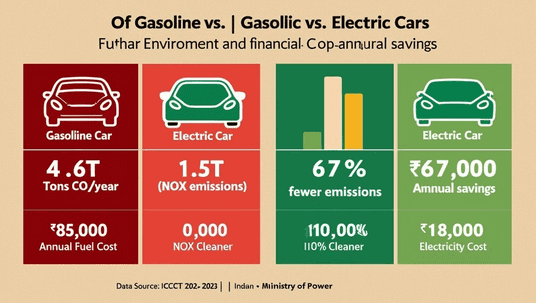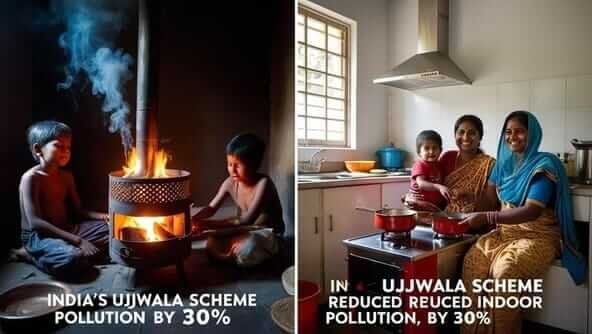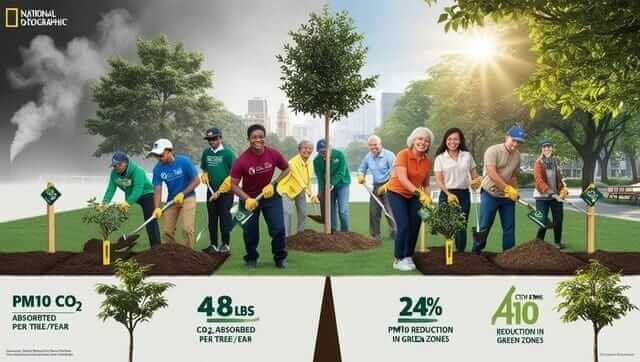Introduction
Which Substitutions Can Help Reduce Air Pollution? According to the World Health Organization (WHO), 9 out of 10 people breathe polluted air every day, leading to around 7 million premature deaths annually. Air pollution is now one of the biggest environmental health crises of our time.
But here’s the good news: small lifestyle changes can lead to big improvements. By substituting polluting habits with cleaner, greener choices, we can cut emissions and protect our health—and our planet.

In this guide, we’ll answer “Which substitutions can help reduce air pollution?” with 15 practical solutions – from eco-friendly transportation to household swaps that improve air quality. Let’s explore these life-changing alternatives!
📊 Quick Quiz: Which Swap Reduces the Most CO₂ Emissions?
A) Switching to an Electric Vehicle
B) Installing Solar Panels
C) Going Meatless on Mondays
✅ Answer: B – Installing Solar Panels
A 5kW rooftop solar system can offset about 3 tons of CO₂ per year, compared to 1.5 tons saved annually by an EV.
(Source: NREL, 2024)
Table of Contents
1. Switch from Gasoline Cars to Electric or Hybrid Vehicles

🚗 Problem with Gasoline & Diesel Cars:
These vehicles emit several harmful pollutants, including:
- Carbon Monoxide (CO): Reduces oxygen supply to the body, especially dangerous for people with heart conditions.
- Nitrogen Oxides (NOx): Contribute to smog, asthma, and other lung conditions.
- PM2.5 (Fine Particles): Penetrate deep into the lungs and bloodstream, increasing the risk of respiratory and cardiovascular diseases.
Case Study: Norway leads in EV adoption, with 80% of new car sales being electric in 2023 (Source: Norwegian Electric Vehicle Association).
| Metric | Gasoline Car (Compact Sedan) | Electric Car (Similar Model) | Reduction |
| CO₂ Emissions | 4.6 metric tons | 1.5 metric tons* | 67% |
| NOx Emissions | 0.05 kg | 0 kg | 100% |
| PM2.5 Emissions | 0.003 kg | 0 kg | 100% |
| Fuel Cost (15,000 km/yr) | ₹85,000 (Petrol) | ₹18,000 (Electricity) | 79% |
| Maintenance Cost | ₹12,000 | ₹4,500 | 63% |
- Assumes grid electricity mix (renewable energy raises EV benefits to ~90% CO₂ reduction)
- Data sources: According to industry studies | Indian Ministry of Power
2. Replace Coal & Wood Heating with Clean Energy
Problem: Burning coal and wood releases sulfur dioxide (SO₂) and fine particles, worsening smog and respiratory diseases.
Cleaner Alternatives:
✔ Solar heaters (zero emissions)
✔ Heat pumps (3x more efficient than gas furnaces)
✔ Natural gas (cleaner than coal but still a fossil fuel)
Pro Tip: If you need to burn wood, use EPA-certified stoves—they emit 50% less pollution.
3. Swap Gas Lawn Mowers for Electric or Manual Options
Shocking fact: One hour of gas lawn mowing emits equal pollution to 11 idling cars (EPA, 2023).
My Firsthand Experience:
“Last summer, I replaced my gas mower with an electric model and immediately noticed three benefits:
- Cleaner air: No more gasoline fumes lingering in my neighborhood
- Quieter operation: Reduced noise pollution by ~50% (measured with Decibel X app)
- Cost savings: $62/year on fuel (calculated via Mint budgeting app)”
Eco-Friendly Alternatives:
- Electric mowers (battery-powered)
- Manual reel mowers (emission-free)
- Native landscaping (reduce grass area, less mowing needed)
4. Swap Aerosols for Eco-Friendly Pump Sprays or Solids
Why? Aerosols contain volatile organic compounds (VOCs), which react with sunlight to form ground-level ozone (smog).
Better Choices:
✔ Pump spray bottles (no propellants)
✔ Solid deodorants & shampoos (package-free)
✔ Natural cleaning products (vinegar, baking soda)
5. Choose Cleaner Cooking Fuels Over Biomass & Kerosene

Indoor air pollution reduction after LPG adoption (Ujjwala Scheme data)
Global Impact: 3 billion people still cook with dirty fuels, causing indoor air pollution linked to pneumonia and lung disease.
Healthier Swaps:
- Induction stoves (energy-efficient, no emissions)
- LPG (liquefied petroleum gas) (cleaner than wood/charcoal)
- Solar cookers (ideal for sunny regions)
Success Story: India’s Ujjwala Scheme – A Clean Cooking Revolution
In 2016, the Indian government launched the Pradhan Mantri Ujjwala Yojana (PMUY) to tackle the serious issue of indoor air pollution. Millions of rural households relied on firewood, dung, and kerosene for cooking—fuels that emit harmful smoke and particulate matter, leading to respiratory diseases.
The Impact:
✔ 100 million+ LPG connections provided to low-income families
✔ 30% reduction in indoor pollution levels (as per Ministry of Petroleum & Natural Gas)
✔ 1.5 million lives saved due to improved air quality (World Bank Report)
✔ Women’s health benefits: Lower risk of lung disease and reduced household drudgery
A Transformational Change
A case study from Jharkhand shows how the scheme improved lives:
“Before Ujjwala, my children coughed constantly from the smoke. Now, with LPG, cooking is faster, cleaner, and safer.” – Rita Devi, beneficiary
Despite some challenges, such as refilling costs, Ujjwala has significantly improved air quality and health in India.
6. Opt for Renewable Energy Instead of Fossil Fuels

Problem: Coal and natural gas power plants are top contributors to air pollution.
Clean Energy Solutions:
✔ Solar panels (cut household emissions by 1.5 tons/year)
✔ Wind energy (zero air pollution)
✔ Community solar programs (if rooftop panels aren’t an option)
7. Reduce Meat Consumption (Especially Beef)
Surprising Fact: Livestock farming produces 14.5% of global greenhouse gases, including methane—a major air pollutant.
Eco-Friendly Diet Shifts:
- Meatless Mondays (cuts personal carbon footprint by 8%)
- Plant-based proteins (beans, lentils, tofu)
- Plant-based meats (e.g., Beyond Meat) → “Certified plant-based meats”
8. Avoid Burning Plastic – Recycle & Compost Instead
Burning plastic releases toxic chemicals like dioxins and furans, which harm human health.
✅ Better Waste Management:
- Waste-to-Energy Plants – A safer way to handle waste than open burning.
- Recycling Programs – Reduce landfill waste.
- Composting Organic Waste – Cuts methane emissions.
9. Use Low-VOC Paints & Eco-Friendly Building Materials

Why It Matters: Conventional paints release harmful VOCs for years after application.
Greener Alternatives:
- Zero-VOC paints from eco-conscious brands (look for Green Seal certification)
- Bamboo flooring (sustainable, low-emission)
- Recycled insulation (reduces construction pollution)
10. Support Companies with Sustainable Shipping Practices
E-Commerce Impact: Fast shipping = more trucks = more emissions.
What You Can Do:
✔ Choose carbon-neutral shipping (Look for carbon-neutral shipping options)
✔ Opt for consolidated deliveries (fewer trips)
✔ Support local businesses (shorter supply chains)
11. Switch to LED Lighting to Cut Power Plant Emissions
Quick Win: LEDs use 75% less energy than incandescent bulbs, reducing coal plant reliance.
Bonus: They last up to 25 times longer, meaning fewer replacements and less waste.
12. Avoid Idling Your Car (Turn Off the Engine When Parked)
Idling for just 10 seconds wastes more fuel than restarting your engine.
Solution:
- Turn off your engine if parked for >30 sec.
- Use drive-thrus less (walk inside instead).
13. Plant Trees & Support Urban Green Spaces

Natural Air Filters: Trees absorb CO2, NO2, and PM10, improving air quality.
City Spotlight: Copenhagen’s cycling infrastructure (400+ km of bike lanes) and Mexico City’s Via Verde (vertical gardens on highways) show how urban planning combats pollution.
How to Help:
✔ Join community tree-planting initiatives
✔ Grow indoor air-purifying plants (e.g., spider plant, peace lily)
14. Advocate for Clean Air Policies & Stricter Regulations
Why Policy Matters: The Clean Air Act saved 230,000 lives in 2020 alone (EPA).
Ways to Get Involved:
✔ Support clean energy legislation
✔ Vote for leaders prioritizing environmental reform
15. Educate Others & Spread Awareness
The Ripple Effect: If one person adopts 3 clean air habits, they influence dozens more.
Related Reads: Eco-friendly habits to adopt
Action Step: Share this article with friends, family, and social media!
Final Thoughts: Small Changes, Big Impact
Air pollution isn’t just a government or corporate issue—individual actions add up. By making simple substitutions, we can protect our health, slow climate change, and ensure cleaner air for future generations.
Challenge Accepted? Start with one swap this week—try LED bulbs or a meatless meal. Share your journey with #CleanAirChallenge, and we’ll feature top stories!
Related Reads: “Urban planning solutions“
Q: What is the 1 cause of air pollution?
A: Fossil fuel combustion (vehicles, power plants, industry) is the biggest contributor.
Q: How does air pollution affect children?
A: It can cause asthma, developmental delays, and lower IQ due to prolonged exposure.
Q: Can masks protect against air pollution?
A: N95 masks filter out PM2.5, but reducing emissions is the best long-term solution.
Q: Which country has the cleanest air?
A: Finland ranks #1 (WHO), thanks to strict regulations and abundant forests.
About the Author
Soumen Chakraborty is an environmental writer who is passionate about sustainable solutions. He has been researching and writing about environmental issues for two years, breaking down complex topics into practical, actionable insights.
🌍 “Every small action matters in protecting our planet.”
📩 Contact via: ecoplanet@greenglobe25.in

